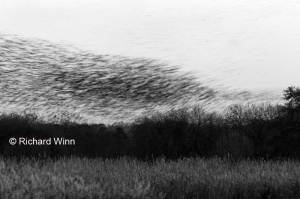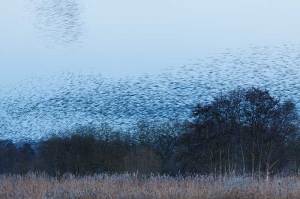Last night, I decided to go and see the starling roost that occurs every evening during the winter months on the Somerset Levels. The roost in the Avalon Marshes area is one of the largest in the country, due to the large area of suitable natural habitat, with the extensive reed beds. Of course the downside is the number of people it attracts, which is the main reason I don’t watch the spectacle more often. Parking is at a premium in the area and some days there can be almost 200 vehicles parked in the small car park and along the verges.
Some of the photographs are spectacular, but there is an element of luck involved (aside from patience and persistence), as no one evening is the same. In wet or windy conditions, the starlings don’t perform and dive straight into their chosen roosting sites. Also, conditions have to be just right to get the vivid colours as a backdrop. Even when conditions are seemingly perfect though, there are no guarantees of a good display and it is thought that the presence of raptors provokes a response; certainly a close examination of the best photos would seem to suggest this. Also, while some years they seem to have a preferred site, they are liable to move around and the past couple of years, they seem to have been much less decisive in where they will roost.

Black and white conversion and slow shutterspeed as roosting starlings fly south, showing a more abstract view.
Yesterday, despite the heavy cloud in the morning, things looked pretty good, the clouds thinned and the sun bathed both of the Shapwick Heath and Ham Wall reserves. However, as sunset appproached, more cloud started to roll in from the west, preventing the vivid colours that make the best photogaphs. It was also quite windy, which didn’t bode well for a good display. However, despite the conditions, it turned out not to be too bad a display, at least they didn’t dive straight into the reeds. In fact, they seemed to be quite indecisive and split into three large groups, coming in at different times. The first group seemed to fly over the reserve from the west to roost to the northeast of the first viewing platform. The second group however, flew more to the south, as did the third, which came in quite a bit later. Finally, the first group seemed to change their mind and flew back south, to roost directly east of the easterly facing screens, to the south of the main path.

